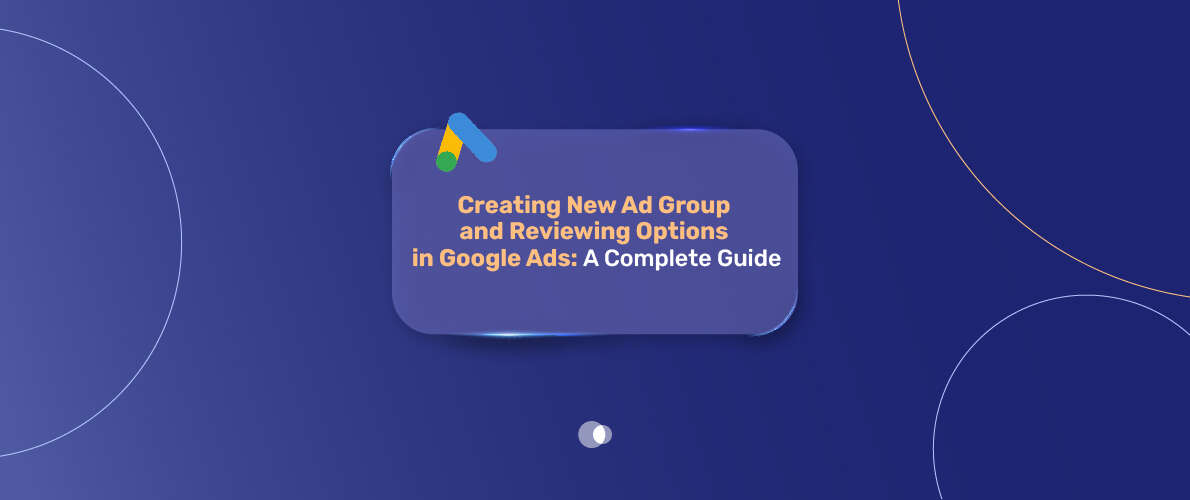Google Advertising is one of the best ways in driving traffic, lead generation and expansion of your business. If you are a small business, or in charge of a large-scale ad campaign, creating new Ad Group structures in the Google Ads platform is crucial to maximizing performance. This guide will help at every stage of the process, from creating new ad groups, to optimizing your ad performance. Along the way, we’ll also learn strategies, tips, and best practices that can help you maximize your campaign efforts.
Table of Contents
When you are done with this article, you will be confident enough about structuring and managing your Google Ads campaigns like a pro. Let’s dive in — whether you’re just starting out or improving your Adwords management Dubai strategy
What Are Ad Groups in Google Ads?
An ad group is one of the major constituents of Google Ads campaigns. It is used to hold your ads, keywords, and your targeting. It is the link between your campaign and the individual ads. All ad groups are based on a particular theme, audience, or set of keywords. Such a structure helps to make your ads related to users’ searches, which can dramatically increase click-through rates (CTR) and conversions.
For example, consider that you are operating a campaign for promoting a poetry site. In the campaign, you could develop ad groups with such topic themes as “Educational Poetry”, “Political Poetry”, and “Social Poetry”. Each of the ad groups would then incorporate the ads that were made for the theme and would use relevant keywords for the theme.
Why Is Structuring Ad Groups Important?
Proper structuring of ad groups is vital for several reasons:
- Relevance: Targeted ad groups will enable you to create targeted ads that will resonate well with the user’s intent.
- Performance Tracking: Organized ad groups make the analysis of metrics and optimization of campaigns easier.
- Budget Control: There are different bidding strategies for each ad group that allows for detailed control over what you are spending on specific keywords.
- Ad Quality: Google will respond to ad relevance by awarding better-quality scores that will give ad placement priority and lowers costs per-click.
Whether you’re looking to fix Google Ads account issues or start fresh, structuring ad groups correctly is the foundation of success.
Step-by-Step Guide to Creating New Ad Group in Google Ads
Step 1: Access Your Google Ads Account
Log into the Google Ads account and go to the campaign that you wish to create an ad group in. You can create an account in a few seconds to start, even if you do not have one. For UAE business owners, consider using Google Ads Dubai services to receive local support.
Step 2: Navigate to the Ad Group Section
In the left side of your interface, find the tab “Ad Group”. Click the blue “+” button in order to add a new ad group. Make sure that you’re on the right campaign to avoid the confusion.

Step 3: Name Your Ad Group
Make sure to give a clear and descriptive name to your ad group. This name should reflect the theme or audience it targets. For instance, if your campaign advertises home cleaning services, you may consider having your ad group to be titled “Apartment cleaning”.
Step 4: Add Keywords
Keywords are the bones of any ad group. Begin with adding a list of keywords which are specifically connected with the topic of your ad group. Use tools like Google’s Keyword Planner to find high-performing keywords. Do not have the same or very similar keywords in different ad groups to avoid internal competition that may increase the cost unnecessarily.
Best Practices for Structuring Ad Groups
The construction of new Ad Group patterns is one of the most useful methods that you can use to enhance your Google Ads campaigns. Effective structuring ensures that your ads are displayed to your target viewer, it enhances relevance as well as ROI efficiency. Here are some best practices that will assist you to achieve Ad Group Optimization and deliver better outcomes.
1. Focus on Specific Themes
Each ad group should revolve around a single theme or audience segment. By doing this you can create highly targeted ads which speak directly to user intent. For example, when your campaign represents a variety of goods, such as home appliances, it is better to form different ad groups for different categories of products – “Refrigerators”, “Microwave Ovens”, and “Air Conditioners”. With such an approach, your ads as well as keywords are well tuned to each other which is important for increasing click-through rates (CTR) and decreasing costs per click (CPC).
2. Use Ad Variations
In each ad group, use several ad variations in order to gain maximum performance. Responsive search ads in particular are a great choice, as they provide Google with an opportunity to do an automatic testing and optimization of different combinations of headlines and descriptions. This makes the most effective ad copy to be presented to the users. For instance, if your target keywords are such as “rent AdWords account”, then you can have several ad copies that will address different user intentions like savings or ease of set-up. Ad variations do not only increase relevance, but also, increase your chances of reaching the right audience.
3. Leverage Negative Keywords
Negative keywords are purely important in rejecting traffic that is not relevant. They help to ensure that your money is spent only on qualified clicks and not wasted. For instance, if your ad group relates to users who are researching “rent AdWords account”, an addition of the negative keywords, such as “free” or “cheap”, can exclude your ads from appearing in queries not very likely to convert. This measure of precision is essential to Ad Group Optimization. Negative keywords also enhance your quality score, hence possible lower CPC and better ad positioning.
4. Review Performance Regularly
Creating new Ad Group structures is not some kind of one-time thing. Ad groups also need constant monitoring and improvement of their process in order to maximize performance. Monitor metrics such as CTR, conversion rates, CPC repetitively to note what is working and what isn’t. If some of the keywords or ads show poor results, look for the better options or improve their targeting. Through constant fine-tuning of your ad groups, you’ll maximize their utility and you’ll be having consistent results across the times.
Common Mistakes to Avoid When Creating New Ad Group
1. Mixing Unrelated Keywords
Each ad group should focus on a tightly-knit set of keywords. Mixing unrelated keywords can dilute your message and lower ad performance.
2. Ignoring Audience Demographics
Take advantage of Google Ads’ demographic targeting options to refine your audience.
3. Skipping Keyword Research
Using irrelevant or low-performing keywords can waste your budget. Invest time in thorough keyword research.
4. Overlooking Ad Group Bids
Remember to set bids at the ad group level. For search campaign this is your maximum CPC bid.
If you are experiencing problems with these issues, then our Google ads optimization services in Dubai can be of great help to you.
Advanced Strategies for Google Ad Groups
1. Use Dynamic Ad Groups
Dynamic ad groups automatically generate ads based on your website content. This is particularly useful for e-commerce businesses with large inventories.
2. Implement Geo-Targeting
Geo-targeting is also priceless to companies that conduct operations in certain areas. Take, for instance, if your target market is in Dubai, customized ad groups specific to Dubai can get better results.

3. Optimize for Mobile Users
Mobile traffic creates a relatively large portion of Google Ads clicks. We recommend that you make sure your ad groups are optimized for mobile devices by using mobile-friendly ad formats and landing pages.
Tools and Resources for Creating New Ad Group
- Google Keyword Planner: Search for high performing keywords for your ad groups.
- Google Analytics: Observe the user behavior and narrow your targeting.
- Heatmap Tools: Investigate the way the users engage with your landing page.
- Admoon Services: For those businesses that are in need of professional help, Admoon provides Google Ads solutions, which are based on your needs.
How Admoon Can Help You Optimize Your Ad Groups
At Admoon, we do not only help businesses to establish and execute effective Google Ads campaigns but specialize in it. If you need to resolve Google Ads account problems or improve an already in operation campaign, our team of experts is at your disposal. We’ve worked over $5 million in ad budgets and produced outstanding results for clients in all industries.
Frequently Asked Questions About Creating New Ad Group
1. How Many Ad Groups Should I Create?
There’s no one-size-fits-all answer. The number of the ad groups will vary depending on the size and the scope of your campaign. As a rough guide, one can do separate ad groups for each segment or categories of services.
2. Can I Edit Ad Groups After Creating Them?
It is possible to edit ad groups anytime. However, some of the changes such as introducing new ads may have a temporary effect on performance.
3. What Is the Ideal Number of Keywords in an Ad Group?
Find 10 to 20 tightly associated keywords for an ad group. Do not over stuff your keywords because this can blur your targeting.
Final Thoughts
One of the ways that you can use to make your campaigns more effective isCreating new Ad Group structures in Google Ads. By clustering ad groups based on particular themes, audiences, or services, you will be able to enhance the relevance of ads, control cost and get better results. Just remember that you need to do good keyword research, use responsive search ads, and keep up performance monitoring too.If you’re ready to take your campaigns to the next level, let Admoon help you. With our expertise in Google Ads, we’ll optimize your campaigns for maximum performance. Contact us today and be a step ahead of your competitors!



